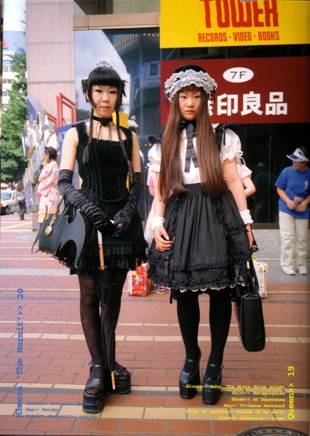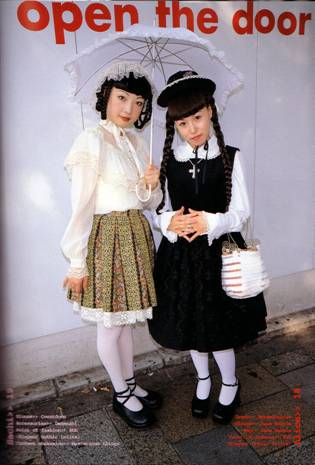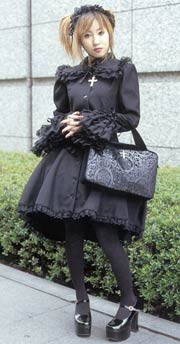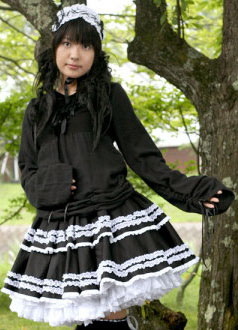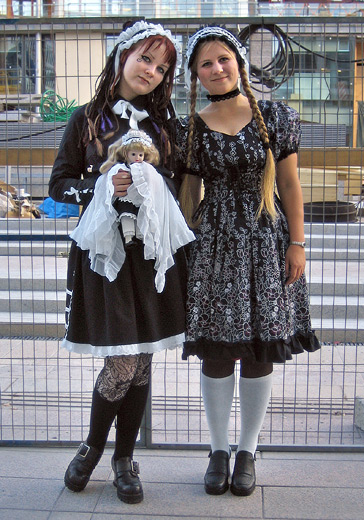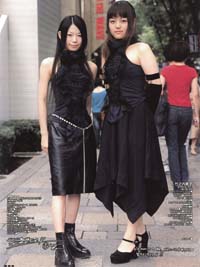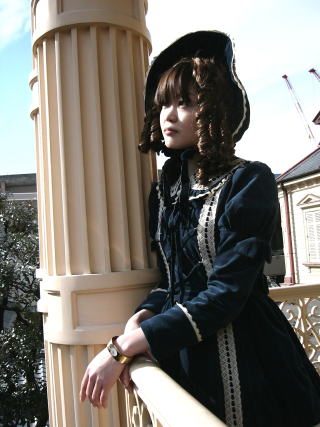|
Gothic Lolitas:
Goth Girls just wanna have Fun! The Gothic eZine - Fashion
Gothic Lolitas: Goth girls just want to have fun.
[Right] Nikole Wiseman of Waterloo's "Delirium" store modelling an outfit. Goth is dead. Long live Goth. Every time we're convinced the Goth movement has drawn its last breath, it manages to gasp and sputter back to life. It usually returns with some of the original symbolism intact, corsets and crucifixes, for example, or dark eye makeup and white faces, but it always comes back in an altered state. In its most recent reincarnation, legions of young Japanese women are dressing up as demure, Victorian children between the ages of 5 and 12. They resemble dolls complete with layers of lace underskirts, small bonnets tied under the chin and a cuddly teddy bear as an accessory, a final touch to reinforce the cute factor. As sweet as it sounds, it is perhaps the most provocative Gothic imagery ever. It's enough to make Anne Rice and her un-dead band of bloodthirsty vampires seem banal by comparison. Move over Lestat. Alice in Wonderland is the new Goth ideal. Ever since Goth surfaced as a splinter category of Punk in 1979, trend watchers have been predicting its death. But if the measure of a trend's staying power lies in its ability to adapt to the times, then Goth might just be the trend-that-won't-go-away. Gothic Lolitas represent a kind of kinder Goth look that appropriates an antiquated imagery of childhood. And whether it is intentional or not, they may also be muddying the costume with ideas of death and sex. This isn't the first time Goth has altered its imagery to stay alive. Back in the early '80s, Goth was characterized by painted white faces, dark eyes, fishnets worn on arms, chipped black fingernails and a predilection for black Victorian or Edwardian clothing. The fashion trend was born from bands like UK Decay, the Banshees and Bauhaus. Since then, there have been hundreds of spin-off Goth sub-categories. Though some traditional Goths still exist as vampire wannabes who celebrate the un-dead and all things dark, new varieties have proliferated. There are sexually ambiguous rockers such as Marilyn Manson, as well as sci-fi, fetish and glam Goths. In Montreal, Ritual Designs, created by Sandra Chirico and Karen Simpson, specializes in cyber and fetish Goth, recognizable by its bright synthetic wigs, strict corsetry and loads of shiny, colourful PVC. Simpson suggests that historically much of the Goth movement has been about "a dark vision of the past." Ritual Designs, however, is more sci-fi, she says. "It's straight out of a cartoon and not so dark."In Tokyo, the image of Goth has shifted to the Gothic Lolita in pinafore, platform Mary Janes and white stockings.
"It's the first new thing to happen to Goth since Marilyn Manson," says Janet Thompson, a former Goth girl who, at 28, still holds a fascination for what she says is "essentially an aesthetic movement. "Goth prides itself on its ability to shock. Because it is an aesthetic, it can change easily. Because it is connected closely to the music it can evolve and splinter like the music," she explains. Tokyo's hottest Goth music is known as visual shock and one of the most popular bands in the movement, Malice Mizer, is fronted by a male Lolita who has his own collection of clothing and his own Lolita stores. It's believed the Gothic Lolita phenomenon is connected to the Japanese "cutie look" that was popularized by the doe-eyed Japanamation and characters, particularly the 14-year-old Lolita-esque anime character Sailor Moon. The colourful cartoon looks were translated into street fashions by the creative youth culture in Tokyo and immortalized by photographer Shoichi Aoki in his zine Fruits, which ultimately provided the images for his book of the same name. He captured his subjects alone or in pairs on the street in Tokyo's Harajuku district, a promenade which has become famous as a weekend supermarket of outrageous fashion. The various costumes in the book include such unlikely hybrids as cowboy nuns, Westwood (these kids are obsessed with British designer Vivienne Westwood) samurais, ballerina Rambos and baby doll space cadets. is another off-beat combination in this weird perversion of American niche culture. A book reviewer for the hip online magazine salon.com commented, "The poses are sly: some are so demure that they must be a ruse, a mockery of the archaic baby-doll, cutie-femme role; others are ironically dopey or snooty, perhaps commenting on the artifice of fashion itself." Many of the kids travel in pairs, a trend known as twinning, in which the friends dress identically. Sometimes the looks are pulled together from vintage finds. Some girls buy their Lolita outfits in stores or on Web sites. Still others make their own Lolita costumes from patterns inserted in the Tokyo based magazine/catalogue called the Gothic And Lolita Bible.
Says Thompson: "Let's face it, a sexed up version of a 5-year-old girl is shocking. Goth is meant to be visually off-putting." There is a Goth culture in Toronto. But it has yet to embrace the Lolita look. They gather at nightclubs The Vatican, Savage Garden, Velvet Underground and Reverb. They shop at Sirens, Heretic and House of Ill Repute. There is one store, however, in Waterloo, Ont., that sees it as the next big thing. Delirium Clothing and Accessories may be the only store in Canada purveying elements of the beautiful and disturbing Gothic Lolita. While this is very much a Tokyo-based phenomenon, sisters Annissa and Lydia Bellenie, who own the store, are working to bring the style here. "I've always been influenced by Victorian style and Gothic culture, specifically the corsetry and ruffles and lace," says Annissa. Delirium has had to incorporate other styles into its stock because the sisters acknowledge an exclusively Goth store would have trouble surviving in Waterloo. A few years ago Annissa began receiving magazines from friends who were on teaching assignments in Tokyo. They were the magazines that ultimately provided the visuals of outrageous street fashions for Fruits. "A lot of these kids go to private schools and most of them wear uniforms. So when Saturday comes around they go crazy," says Annissa. She believes the original imagery is inspired by a mix of the main character in Alice in Wonderland, the books of Edward Gorey and the children in The Secret Garden. Think of the Addams Family as Goth characters: Lolitas are more Wednesday than Morticia.
"I'd rather have a child of mine dress like this than like Britney Spears. There is something strange about a very young girl in low rise pants and a tight top that reveals everything," says Annissa. Like Thompson, Annissa is convinced Gothic Lolitas are only copying an esthetic. Though she admits that through North American eyes, there is something deeply disturbing about a young woman dressed like a child, it's her contention that the clothes carry no message. They are just playing dress-up. They are not anarchists. The Gothic Lolita is another example of how Japan's popular culture has appropriated imagery without the content. Witness the past interest in Elvis and `50s American culture, for example. It was a superficial and accurate take on a cultural phenomenon, and the motivation was completely devoid of irony. Likewise, the Victorian costumes are huge signifiers in Western culture. We interpret the wearing of such clothing as infantalizing women, but the criticism is lost on the Tokyo Gothic Lolitas much the same as we would not understand the subtle meanings associated with various styles of kimonos. In Japan, though, fashion trends are about visual stimulation. After all, Tokyo is a massive city dominated by a culture that demands conformity. "The nail that sticks up gets hammered down," was a common admonition toward children who dared to express their individual personality. So it should come as no surprise that Goth girls are going farther than ever in their plea for attention.
|
|
|
Defining the Gothic Lolita: Gothic Lolita, as a more specific subset of Lolita fashion, has a great deal in common with Lolita style, in particular the nostalgic drive. One Lolita writes, “Personally, I like the Gothic Lolita fashion because it’s complicated and elegant and a return to an older time. . . . It is not about being shocked or sinister. It is about being cute, sweet, elegant, or refined”.
Gothic Lolita is a distinctive style, though. Sweet or country Lolita is typically very innocent and girlish. Gothic Lolita, however, places more emphasis on the elegant elements of the style and typically is limited in color to black and white (with the occasional bit of red). Gothic Lolita, like sweet Lolita style, is inspired by Victorian clothing, but more particularly Victorian mourning clothing. It has been described as “French Maid meets Alice in Wonderland style” (Hell). The knee-length skirts and frills of the style mark it as particularly girlish while the fullness of the skirts, along with the types of materials used (velvet, brocade, etc.), mark it as more grown-up and serious. As there are cultural concepts that do not translate well within sweet Lolita style (particularly the sexualized references to Nabokov), Gothic Lolita suffers from the same problem. The “Gothic” of the title is in no way associated with the Gothic style Westerners are familiar with. It represents for these girls and young women a period of elegance rather than scary stories and a morbid approach to life. The combination of the two elements of the style (Gothic/elegant and Lolita/childlike) is somewhat difficult to reconcile. Jane Pinckard attempts to reconcile the two in her analysis: “Maybe the GothLolitas are trying to dress like cute but creepy dolls. Maybe it’s the very cuteness, the prettiness, which is creepy. There’s a lot of ambient creepy cute in Japan. We are dolls, they seem to say, but don’t play with us. We bite. The creepy cuteness is meant to disturb, to provoke. The ‘Lolita’ is alluring, but the ‘Goth’ says you might not like what you get. . . . This over-elaborateness is meant to be attractive and repulsive at the same time. . . . I read this look as a challenge to societal attitudes about femininity: girls are not all innocent until they hit eighteen. There’s more to young female psyche than that. At the same time, it is a dark parody of girlhood drawn from romanticized images of Holly Hobby and Beatrix Potter. They’ve taken these and made them, in their inimitable way, essentially Japanese.” This look is multiply coded and, in fact, so overcoded that its various elements are emptied of all previous contextual meaning, leaving an open space that the Lolitas can then recode as they wish.
Nostalgia Marilyn Ivy, in Discourses of the Vanishing, is concerned with the workings of nostalgia in modern Japan, a nostalgia for an imagined time before Western influences. Her analysis of this nostalgia looks primarily at efforts to emphasize the folk elements of Japanese culture, but Lolita and Gothic Lolita adherents emphasize a similar nostalgia, a desire for a simpler time. However, their desire is more complex, as it seems to recognize in its very reliance on Western influences (both literature and fashion) that this more innocent, pre-Western time is a fiction. The style is nostalgic, but it is not about glamorizing any real British life or any real past that exists objectively; this style (and sweet Lolita) is instead a nostalgia for an entirely fictional past, a past that they would like to have existed. Ivy writes, “the consuming and consumable pleasures of nostalgia [function] as an ambivalent longing to erase the temporal difference between subject and object of desire, shot through with not only the impossibility but also the ultimately unwillingness to reinstate what was lost. . . . The linkage of recognition and disavowal describes what in psychoanalytic criticism is known as the logic of the fetish, the denial of a feared absence through its replacement with a substitute presence” (10). Arguably, these fashions represent a “substitute presence,” a way of acknowledging the sense of loss and nostalgia that Ivy discusses without dealing with it in such direct terms.
As a nostalgic fetish, Lolita style presents a critique of the current world. Nostalgia is a strong impulse during periods when the contemporary world is frightening or uncertain. For many young people in contemporary Japan, this is indeed the case. They are unlikely to starve, but many college graduates have difficulty finding a job and even more live with their parents until they are in their 30s. In fact, “‘Japanese people don’t want to be growing up so quickly,’ [Masanobu] Sugatsuke [editor of Composite, a fashion/culture magazine] told [Rebecca Mead]. ‘They would like to stay young mentally and socially.’ In Japan, living at home with your parents and going shopping every weekend is a form of rebellion” (Mead). Community Gothic Lolita fashion provides relief from the uncertainties of modern life in Japan in another way as well. As Marilyn Ivy recognizes, “communal spaces of performance” are a central means of dealing with cultural nostalgia. Lolita and Gothic Lolita culture (more than the other fashion subcultures explored here) involve a tightly knit and recognizable community, as well as a sense of performance. Rebecca Mead provides one description of the community created by such a uniform: The kids on the bridge [in Harajuku] are misfits of a sort. There was one unusually fat girl with a white-painted face, wearing her school uniform: short skirt, thick cream-colored leg warmers rumpled around her ankles like the skin of an ancient elephant. . . . “I come here to have a relationship with other people and to see my friends,” she told me, and it was hard to imagine another fashion scene into which someone of her size would fit.
Commodification However, Mead acknowledges the limited nature of this kind of communal rebellion as she notes that “their rebellion is a kind of performance which is grounded on a thriving commercial foundation: entire stores are devoted to selling the ‘gothic Lolita’ outfits; and the inspiration for most of their looks comes from what are known as bijuaru-kei rokko bando, ‘visual-type rock bands’: groups like Dir En Grey, five heavily made-up young Japanese men whose music is little more than an excuse for their often changing costumes.”
This community is so clearly defined and easily recognizable in part because it is so easily copied and commodified. The Gothic and Lolita Bible, a series that provides how-to tips for achieving the Gothic and Lolita looks sets out the “rules” for EGL dressing. If one wishes to fit into this group, one need only follow the instructions. Furthermore, as Kyshah Hell points out, “A person can look at an EGL [Elegant Gothic Lolita] in Yoyogi Park and walk across the street to one of the many mall stores and purchase that look from head to toe. This is of course a curious and magnificent aspect of all mass marketed subcultures. Even though some costumes are partially or all homemade, the Gothic Lolita style is quite rigidly followed.” What is wonderful and empowering for this subculture—its reliance on individuality, on separation from the mass-marketed mainstream—is undercut as entry to the subculture is opened up to more people. Unfortunately, this is the fate of most youth subcultures. As they gain power, they are taken over and sold off to those who already hold the power, thus stripping the subculture itself of any power for its creators.
| |

